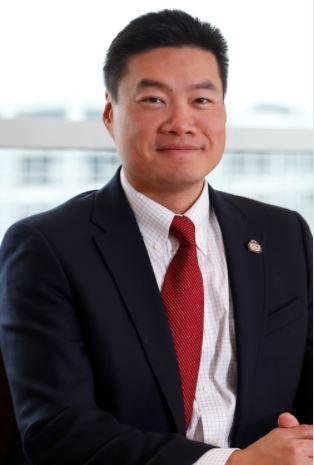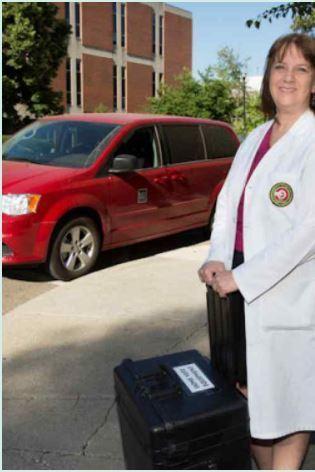The Optometry Clinics at the OSU College of Optometry see a broad range of patients from all walks of life. Sometimes, students and faculty encounter a patient in need of life-changing contact lens correction but who are unable to afford the lenses they need. The Adopt-a-Patient® program allows optometry students during their clinical rotation to give back to their communities by "adopting" a deserving patient who lacks the necessary resources to purchase contact lenses. CooperVision donates an annual supply of contact lenses that can be given to a well-deserving, low income patient.

Nicky Lai, OD, MS is a clinical professor at OSU and has been instrumental in encouraging students to utilize the CooperVision Adopt-a-Patient® program to serve those patients in need. “We have been working with the program since its launch about 5 years ago,” says Dr. Lai. “Mark Andre (of CooperVision Professional Affairs) presented the program to us, and we thought it was a great way to provide our patients with an opportunity to experience contact lens wear who may not otherwise have had the opportunity due to financial constraints.”
Dr. Lai reports that OSU’s main clinic utilizes the program for roughly 20 patients per year. Patients who could benefit from the program are identified by student interns and attending doctors. “Our patient population ranges from University students and faculty, residents of our surrounding community, and patients on government assistance programs,” says Dr. Lai. “Most of our contact lens patients are able to afford their contact lenses but we do encounter a large population of patients that are not able to afford even basic health care costs. Especially in cases where the patient can benefit from contact lenses beyond cosmetic reasons and the patient is unable to afford contact lenses, we will mention the program and ask if the patient is interested in participating.”

The College has also recently incorporated the Adopt-a-Patient® program at their outreach clinics, including the Faith Mission – an area homeless shelter. At the Faith Mission, they have used the program to provide contact lenses to 20 patients over the past two years. Joan Nerderman, OD staffs the clinic at Faith Mission and says that patient selection is key for ensuring a successful outcome for their unique patient population. “With the homeless population at Faith Mission, it comes down to being at a place in their life where they can be responsible for the care and removal of the lenses,” says Dr. Nerderman. “This means currently not using drugs (especially good for those who are in or have completed a recovery program), those who are actively job hunting or who have high prescriptions. Also, many of our patients live in a tent with minimal access to a sink, so contacts are not a safe option for them. Contacts work much better if they are staying at a shelter.” Bearing those considerations in mind, Dr. Nerderman teaches her students to identify those who are good candidates for the program. “The students will come to me if they feel a patient would be a good fit for the program and we discuss lens options for their situation and whether they are truly a good candidate. I appreciate that we can fit them as we please without any limits, but I also appreciate the program and try to save it for those with a real need so as to not abuse this wonderful donation.”
Both Dr. Lai and Dr. Nerderman agree that utilizing the Adopt-a-Patient program for the right patients is tremendously rewarding. Dr. Lai recalls a particularly memorable contact lens fit for a child in need. “We have a long-time patient from our pediatric clinic that has a high amount of hyperopia and astigmatism and was treated for amblyopia,” recalls Dr. Lai. “Spectacle wear became more difficult due to her high prescription and active lifestyle. We were interested in fitting her with contact lenses to provide more consistent visual correction but her family was unable to afford the lenses, especially in the extended ranges that she needed. We were able to fit her with Proclear Toric XR lenses (and more recently, Biofinity® XR Toric lenses), to provide the vision correction she needs to maintain vision in both eyes. Every year she is adopted by a new 4th year student and it has been remarkable to see this young lady grow in confidence year after year.”
Dr. Nerderman also recalls the life-changing effect the Adopt-a-Patient program has had at the Faith Mission and the way it has impacted so many lives. “One recipient was a middle-aged woman who had been held hostage for months by a man and who was a past drug abuser herself,” says Nerderman. “She had just completed a recovery program and was job hunting. She felt so much more confident wearing contact lenses and readers than thicker glasses.” Dr. Nerderman says that the program has been used many times to help abuse victims who are starting over with their lives. “There were 3 patients who were wearing very old lenses, sometimes not even theirs - and maybe only one lens since they did not own glasses. One had been sleeping in the same one lens for the past 6 months—he never removed it. All of these examples are something that is just hard to comprehend by us with fairly uneventful lives with minimal hardships.”
Dr. Nerderman says the providing these patients with contacts is a very emotional experience. “More than one have started to cry when they realized we could do this for them – something that seemed so out of reach to them. It just helps them feel more like they are overcoming their difficult pasts: one step closer to the life they had before drugs, before abuse, etc.”
Both Dr. Lai and Dr. Nerderman also make note of the profound benefit to the students who have the opportunity to fit patients through the Adopt-a-Patient® program. “Our students are able to experience how contact lenses can benefit patients in need and to see the advantages of offering better options for patients without worrying about patient costs,” says Dr. Lai. “This motivates the students to offer better options and educate about benefits to all of their patients instead of staying with the status quo,” he notes. “We are all in this profession to offer our patients the best care we can provide. As with any health care, sometimes cost gets in the way when it shouldn’t. The Adopt-a-Patient® program allows our students and doctors to provide the best for our patients without constraints.”
Dr. Nerderman says that the primary thing she sees her students learn from this program, aside from the practical clinical experience, is compassion. “I think being able to offer contact lenses for extreme prescriptions and in extreme situations helps the externs appreciate how even fitting contact lenses can make a patient feel more like their old selves. Being able to offer a year’s supply… it’s just overwhelming.”
For more information on the Adopt-a-Patient® program, visit our information page.





